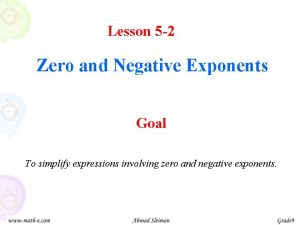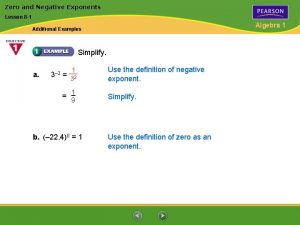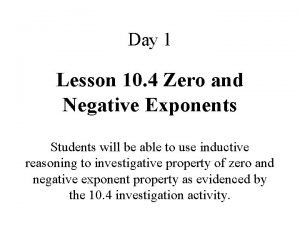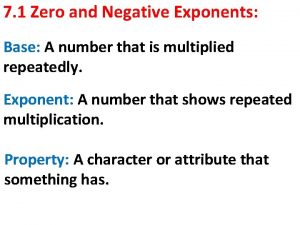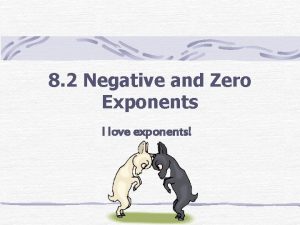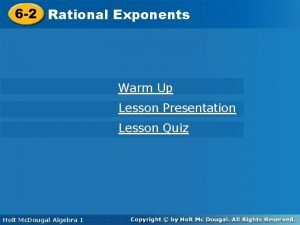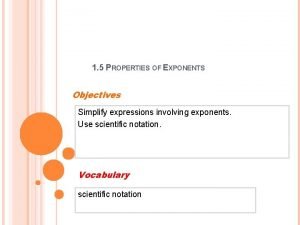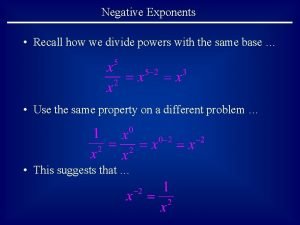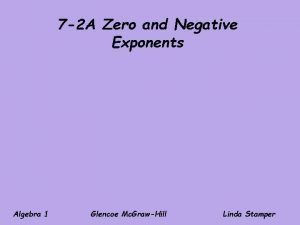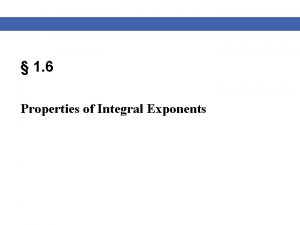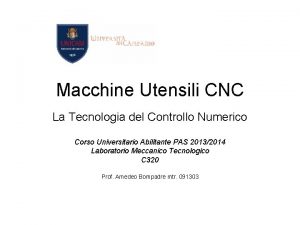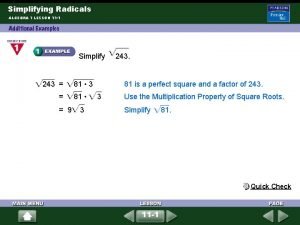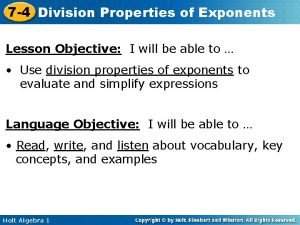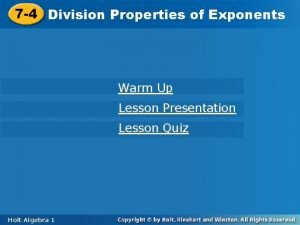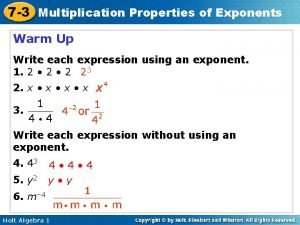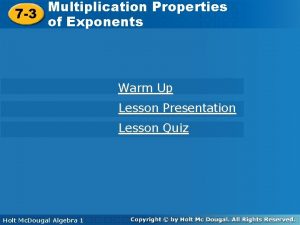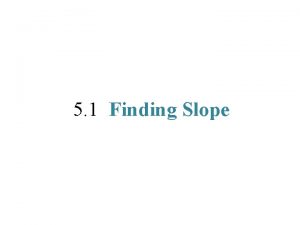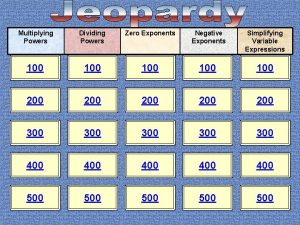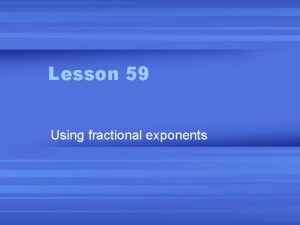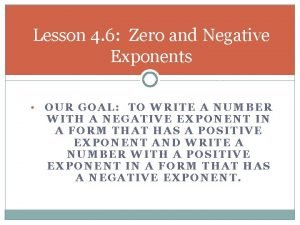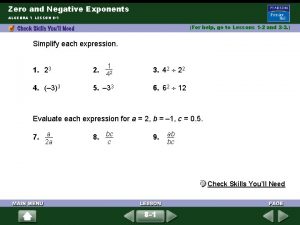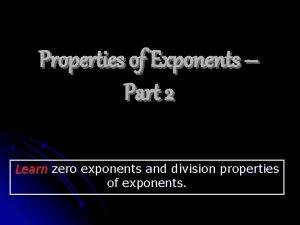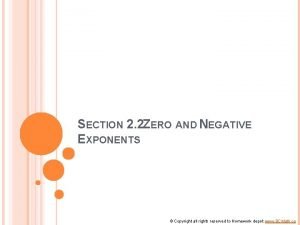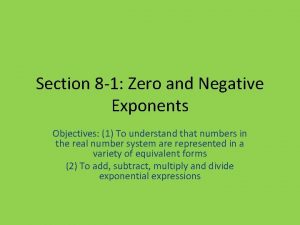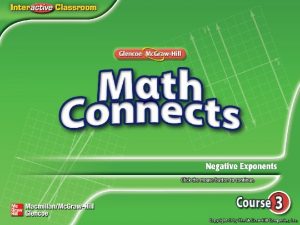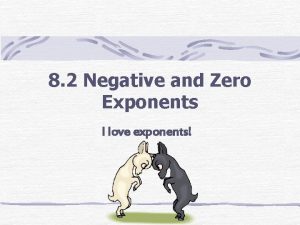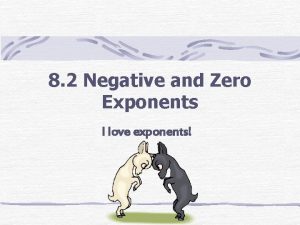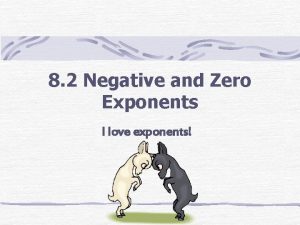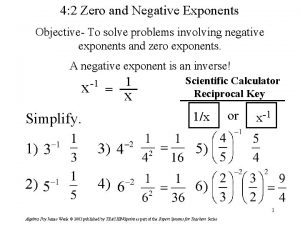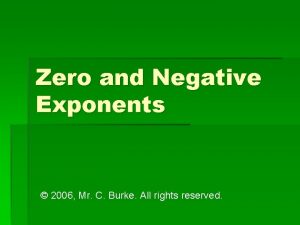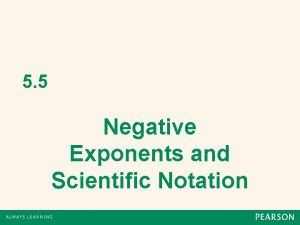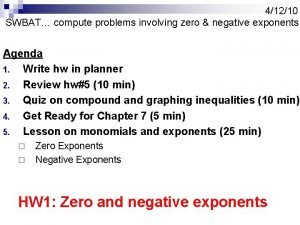Negative and Zero Exponents Lesson 5 2 1






















- Slides: 22

Negative and Zero Exponents Lesson 5. 2. 1

Lesson 5. 2. 1 Negative and Zero Exponents California Standards: What it means for you: Number Sense 2. 1 Understand negative whole-number exponents. Multiply and divide expressions using exponents with a common base. You’ll learn what zero and negative powers mean, and simplify expressions involving them. Algebra and Functions 2. 1 Interpret positive whole-number powers as repeated multiplication and negative whole-number powers as repeated division or multiplication by the multiplicative inverse. Simplify and evaluate expressions that include exponents. Key words: • base • exponent • power 2

Lesson Negative and Zero Exponents 5. 2. 1 Up to now you’ve worked with only positive whole-number exponents. These show the number of times a base is multiplied. As you’ve seen, they follow certain rules and patterns. 1212 83 3256 20 2– 6 916 122 100 4– 3 6– 7 84 100 17– 2 2– 256 4– 10 The effects of negative and zero exponents are trickier to picture. But you can make sense of them because they follow the same rules and patterns as positive exponents. 3

Lesson 5. 2. 1 Negative and Zero Exponents Any Number Raised to the Power 0 is 1 Any number that has an exponent of 0 is equal to 1. 1 0 0 0 So, 2 = 1, 3 = 1, 10 = 1, 2 0 = 1. For any number a ¹ 0, a 0 = 1 You can show this using the division of powers rule. 4

Lesson 5. 2. 1 Negative and Zero Exponents If you start with 1000, and keep dividing by 10, you get this pattern: 1000 = 103 100 = 102 10 = 101 1 = 100 Now divide by 10: 103 ÷ 101 = 10(3 – 1) = 102 Now divide by 10: 102 ÷ 101 = 10(2 – 1) = 101 1 1÷÷ 10 1 1==10 (1(1 – 1)==10 00 Now divideby by 10: 10 10 10 The most important row is the second to last one. When you divide 10 by 10, you have 101 ÷ 101 = 10(1 – 1) = 100. You also know that 10 divided by 10 is 1. So you can see that 100 = 1. 5

Lesson 5. 2. 1 Negative and Zero Exponents This pattern works for any base. For instance, 61 ÷ 61 = 6(1 – 1) = 60, and 6 divided by 6 is 1. So 60 = 1. You can use the fact that any number to the power 0 is 1 to simplify expressions. 6

Lesson 5. 2. 1 Example Negative and Zero Exponents 1 Simplify 34 × 30. Leave your answer in base and exponent form. Solution 34 × 3 0 = 3 4 × 1 = 34 You can use the multiplication of powers rule to show this is right: 34 × 30 = 3(4 + 0) = 34 Add the exponents of the powers You can see that being multiplied by 30 didn’t change 34. 7 Solution follows…

Lesson 5. 2. 1 Negative and Zero Exponents Guided Practice Evaluate the following. 1. 40 1 2. x 0 (x ¹ 0) 1 3. 110 + 120 2 4. (7 + 6)0 1 5. 43 ÷ 43 1 6. y 2 ÷ y 2 (y ¹ 0) 1 7. 32 × 30 32 or 9 8. 24 × 20 24 or 16 9. a 8 ÷ a 0 (a ¹ 0) a 8 8 Solution follows…

Lesson 5. 2. 1 Negative and Zero Exponents You Can Justify Negative Exponents in the Same Way By continuing the pattern of powers shown below you can begin to understand the meaning of negative exponents. 1000 = 103 100 = 102 10 = 101 1 = 100 Now divide by 10: 103 ÷ 101 = 10(3 – 1) = 102 Now divide by 10: 102 ÷ 101 = 10(2 – 1) = 101 Now divide by 10: 101 ÷ 101 = 10(1 – 1) = 100 9

Lesson 5. 2. 1 Negative and Zero Exponents Carry on dividing each power of 10 by 10: 100 = 102 10 = 101 1 = 100 1 = 10– 1 10 1 = 10– 2 100 1 = 10– 3 1000 Now divide by 10: 102 ÷ 101 = 10(2 – 1) = 101 Now divide by 10: 101 ÷ 101 = 10(1 – 1) = 100 Now divide by 10: 100 ÷ 101 = 10(0 – 1) = 10– 1 Now divide by 10: 10– 1 ÷ 101 = 10(– 1 – 1) = 10– 2 Now divide by 10: 10– 2 ÷ 101 = 10(– 2 – 1) = 10– 3 10

Lesson 5. 2. 1 Negative and Zero Exponents Look at the last rows, shown in red, to see the pattern: 1 = 10– 1 10 1 = 10– 2 100 1 = 10– 3 1000 Now divide by 10: 10– 1 ÷ 101 = 10(– 1 – 1) = 10– 2 Now divide by 10: 10– 2 ÷ 101 = 10(– 2 – 1) = 10– 3 1 1 1– 11 11 – 2. – 3. One-tenth, which is , iscan rewritten as 1 =as 10 One-thousandth, which is be , can rewritten as 2. =310 = 10 One-hundredth, , can bebe rewritten 10 1000 10 1010 11

Lesson Negative and Zero Exponents 5. 2. 1 This works with any number, not just with 10. For example: 60 = 1 1 1 – 1 = and 1 ÷ 6 = , so 6 =. 6 6 1 1 1 – 2 6 ÷ 6 = 6 and ÷ 6 = • = 2 = , so 6 =. 36 6 6 60 ÷ 61 6– 1 This pattern illustrates the general definition for negative exponents. 1 –n For any number a ¹ 0, a = n a 12

Lesson 5. 2. 1 Example Negative and Zero Exponents 2 Rewrite 5– 3 without a negative exponent. Solution 5– 3 1 = 3 5 Using the definition of negative exponents 1 = 125 13 Solution follows…

Lesson 5. 2. 1 Example Negative and Zero Exponents 3 1 Rewrite 5 using a negative exponent. 7 Solution 1 – 5 = 7 75 Using the definition of negative exponents 14 Solution follows…

Lesson Negative and Zero Exponents 5. 2. 1 Guided Practice Rewrite each of the following without a negative exponent. 10. 7– 3 1 73 11. 5–m 1 5 m 12. x– 2 (x ¹ 0) 1 x 2 15 Solution follows…

Lesson Negative and Zero Exponents 5. 2. 1 Guided Practice Rewrite each of the following using a negative exponent. 1 3– 3 13. 33 1 14. 4 6 6– 4 1 15. (q ¹ 0) q×q×q q– 3 16 Solution follows…

Lesson 5. 2. 1 Negative and Zero Exponents Independent Practice Evaluate the expressions in Exercises 1– 3. 1. 87020 1 2. g 0 (g ¹ 0) 1 3. 20 – 30 0 17 Solution follows…

Lesson Negative and Zero Exponents 5. 2. 1 Independent Practice Write the expressions in Exercises 4– 6 without negative exponents. 1 45 4. 45– 1 5. x– 6 (x ¹ 0) 6. y– 3 – z– 3 1 x 6 (y ¹ 0, z ¹ 0) 1 1 – y 3 z 3 18 Solution follows…

Lesson 5. 2. 1 Negative and Zero Exponents Independent Practice Write the expressions in Exercises 7– 9 using negative exponents. 1 8– 2 7. 82 1 8. (r ¹ 0) r 6 r– 6 1 9. (p + q ¹ 0) v (p + q)–v 19 Solution follows…

Lesson 5. 2. 1 Negative and Zero Exponents Independent Practice In Exercises 10– 12, simplify the expression given. 10. 54 × 50 54 11. c 5 × c 0 (c ¹ 0) c 5 12. f 3 ÷ f 0 (f ¹ 0) f 3 20 Solution follows…

Lesson 5. 2. 1 Negative and Zero Exponents Independent Practice 13. The number of bacteria in a Petri dish doubles every hour. The numbers of bacteria after each hour are 1, 2, 4, 8, 16, . . . Rewrite these numbers as powers of 2. 20 , 2 1 , 2 2 , 2 3 , 2 4 1 14. Rewrite the numbers 1, , , and as powers of 2. 2 4 8 0 – 1 – 2 – 3 2 , 2 , and 2 21 Solution follows…

Lesson 5. 2. 1 Negative and Zero Exponents Round Up So remember — any number (except 0) to the power of 0 is equal to 1. This is useful when you’re simplifying expressions and equations. Later in this Section, you’ll see how negative powers are used in scientific notation for writing very small numbers efficiently. 22
 Lesson 5 negative exponents
Lesson 5 negative exponents Zero and negative exponents examples
Zero and negative exponents examples Zero and negative exponents worksheet
Zero and negative exponents worksheet 7-1 zero and negative exponents answer key
7-1 zero and negative exponents answer key Negative and zero exponents
Negative and zero exponents Exponent warm up
Exponent warm up Evaluate expressions using properties of exponents
Evaluate expressions using properties of exponents How to divide powers
How to divide powers Negative exponents chart
Negative exponents chart Negative integral exponents examples
Negative integral exponents examples Exponent rules jeopardy
Exponent rules jeopardy Zero defect zero effect
Zero defect zero effect Cnc alapismeretek
Cnc alapismeretek Practice 11-1 simplifying radical answers
Practice 11-1 simplifying radical answers Lesson 7-4 division properties of exponents
Lesson 7-4 division properties of exponents Raised to negative exponent
Raised to negative exponent 4 divided by 3
4 divided by 3 7-3 multiplication properties of exponents answers
7-3 multiplication properties of exponents answers 7-1 practice multiplication properties of exponents page 8
7-1 practice multiplication properties of exponents page 8 Multiplication properties of exponents
Multiplication properties of exponents Life below zero: bank lending under negative policy rates
Life below zero: bank lending under negative policy rates Perfect continuous conditional
Perfect continuous conditional Orizontal
Orizontal
